Sex realists have strong feelings about drag queens especially as they have become part of the Queering of society in programs for children known as Drag Queen Story Our. The founders of DQSH having stated in an academic paper titled “Drag Pedagogy: The Playful Practice of Queer Imagination in Early Childhood” that such “playful practice” aims to subvert social boundaries by breaking the rules, manifested by the drag queen visually breaking the rules of the presentation of sex characteristics.
The touted benefits of such rule-breaking were to, not only familiarize children with Queer culture and thus combat homophobia and transphobia but to destigmatize effeminate expression and encourage children to find, by imitation of the drag performance, a venue for creative inspiration and self-expression.
Children, however, are not mini-adults sheltered and repressed by adult authority figures. They are engaged in crucial developmental stages of learning to discern what is reality who they are in this reality in order to understand that their sex is real and unchangeable. They don’t know the rules of sex presentation well enough to break them yet. Adults are already confused by the use of “preferred pronouns” and the coopting of standard terms like man and woman. To expect a child to maintain their hold on this reality is a tenuous ask given the entire package of this “queering” of the language.
There is also a huge concern that such drag queen presentations lower safeguarding standards when coupled with the indoctrination of such trans language. We are asking children to trust that a man who says he is a woman is as safe as their own mother. That they are not to trust their own eyes and ears first. Adult men drawn to this work with children are also suspect.
In my experience in the gay community it had never been a part of drag culture to engage in this sort of public deception. In fact, it was considered part and parcel of the fun to openly acknowledge that a drag queen was really a man. During the era when it was illegal to wear the clothes of the opposite sex on the street, drag artists would wear badges printed with the words “I am a boy” in defiance of such cross-dressing laws. Trans ideology captured drag to further its own agenda.
Into this tricky territory between resistance to trans ideology and the reclaiming of drag as a gender non-conforming ally of sex realists, I ventured with my sex realist comrade Sasha.
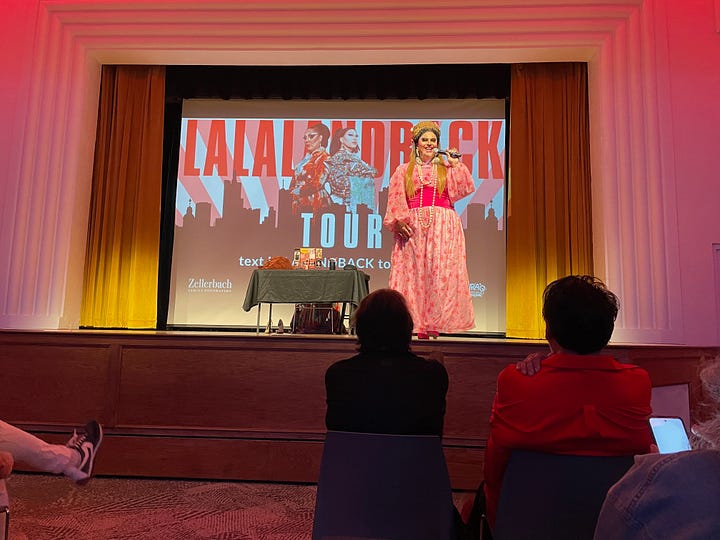



A sex realist pal and I attended a drag show hosted by her old friend and college roommate (at the University of Oklahoma), whose drag name is Landa Lakes. The LALALANDBACK Tour, billed as an Indigenous Variety Show, featured Landa Lakes and co-host Ladyshugdrag and their young friends, a drag king performing a song from the movie COCO, and a man from Guatemala of Mayan heritage.
Held at the Chan Queer Arts Center, an impressive performance space founded by the SF Gay Men’s Chorus, this was a lively, humorous, and warm-hearted show in the tradition of drag as it intersected with Native American culture. This included the presenters' storytelling of the gay origins of drag and self-expression this allowed for the artistic inspiration of the drag artist.
After the customary land acknowledgment to the Natives of the area, Landa Lakes bid everyone join in the intersectional theme of the show by asking us to stand up when our particular identity class was called out. This included white people. Mine was “people of color”. My friend got a special welcome as the roommate from way back with a funny story about how they both got their septum pierced at the same time.
While most of the show was comedy having nothing to do with identity and lip-synched musical numbers some of which referenced the native culture of the artist, the final ceremonial number was a moving tribute to the stolen children of Native people whose culture was destroyed through the abduction of their children into Christian boarding schools where they were forbidden to speak their native tongue, wear Native garb or reference any part of their native culture while being indoctrinated with the language and cultural customs of Christianity.
Drag has always been one of my favorite aspects of gay culture. I first saw a man do drag in England performing in a variety show I attended with my parents when I was 18. He performed one number in drag and then went back to being a “fella”. This performance spoke to me of my own homosexuality and cross-dressing expression as it could be integrated into the rest of straight culture.
That was before it was deemed that heteronormativity was to be destroyed by Queer theory and the Queering of society that ensued. This queering aims to destroy the very integration into my family of origin that had so comforted me as a young person. It destroyed the concept that I could still be a part of my family and culture of origin while having a place in it.
Family support was vital to my well-being as a mixed-race person coming of age in three separate cultures. I was faced with immersion in each culture which had its challenges, but the exposure also allowed me to choose from each what appealed to me. The tools from each tradition kept me grounded in distinct geographic regions while offering a legacy of knowledge with which to build my arsenal of skills. Ultimately I benefited from these three different cultural strategies (embodied in language) with which to negotiate the world.
Thus my objection to this Queering of society and my reason for co-creating the resistance with my sex realist mates against what our Maori activists in New Zealand call the second colonization. In sex realist parlance, the Queering of society is compared to the abduction of children into a foreign, colonizing culture that destroys the culture of the family and the traditions of the people of that family of origin.
Children who are hijacked into the trans culture are tasked with the demands of the colonizing trans language to demand that their family members use pronouns and ideological concepts of being born in the wrong body that unhinge from reality, the agreed-upon reality of our culture of origin. These youth are told they are being literally abused if this language is not used and that this rejection of trans language is part of the trans "genocide". Non-complying parents are threatened with the final solution of going no-contact with the family of origin. I cannot think of anything more devastating.
My friend and I did not bring this up when we met with our drag host after the show. We had no complaint with the presentation and honest expression of a cross-dressing tradition common to so many cultures worldwide (save for the puritanical one that came to America). Neither could we find a reason to object to such a presentation being displayed to children at the story hour offered earlier. Our host was not performing a sexualized version of a pornified female. He was dressed in home sewn garments and presented his own culture’s storytelling traditions that just happened to coincide with the current zeitgeist. We walked away in a good mood happy to enjoy a summer night in the vital mixing of cultures that is the Mission neighborhood.
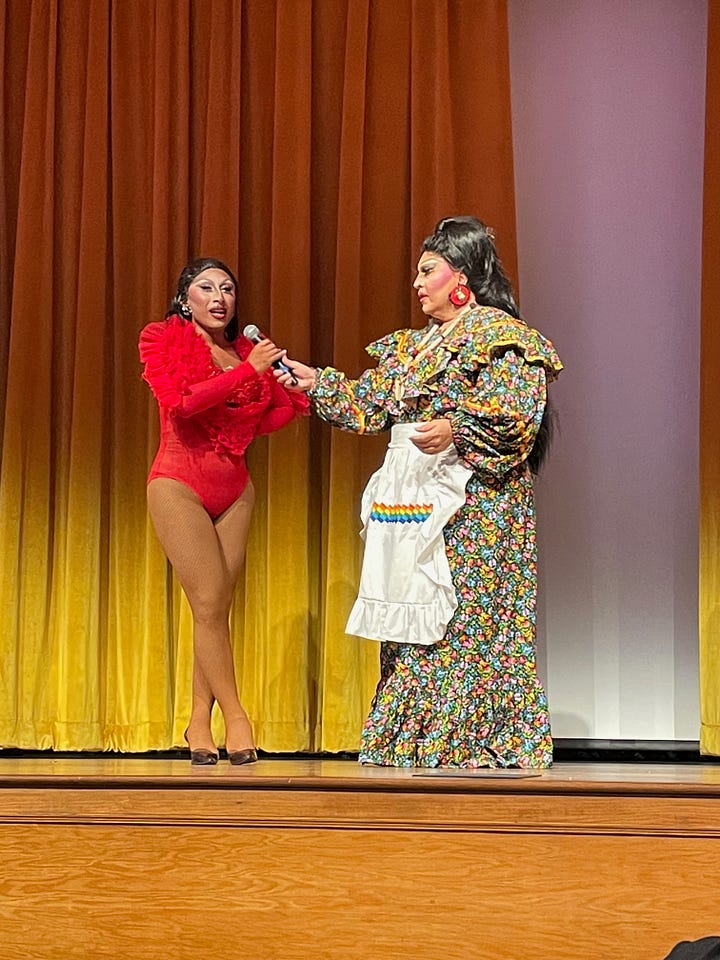

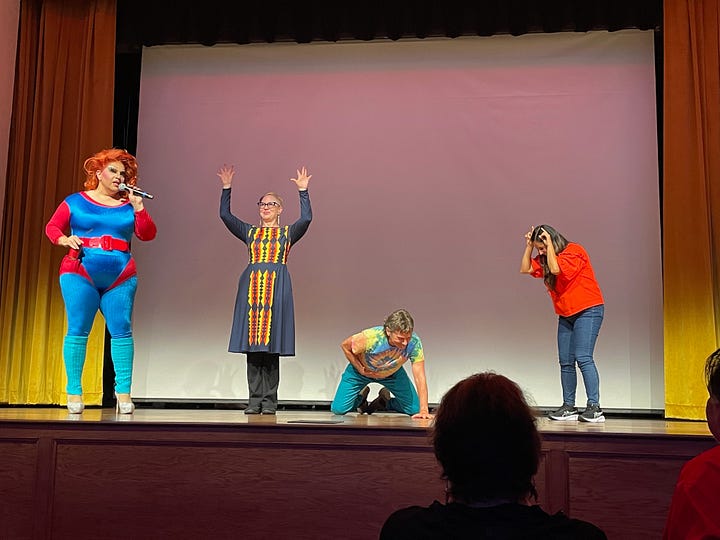

My friend Sasha had already written a glowing review of the show on her page which helped me get oriented and filled in some details. She did me the favor of adding to my story, in a comment, providing more information about our drag artist host.
Sasha: Landa Lakes is a beautiful man with a “two spirit” inside of him who befriended me over 30 years ago in a film focused freshmen English class. He had a rough upbringing in and out of his Chickasaw culture and realizing he was gay at a time when gayness had been bleached out of Native communities through Christianity and Indian boarding schools. It was fascinating to be immersed in the youth cultures forming at the University of Oklahoma in the late 80’s. My African American friends from high school discovered pan-Africanism and embarked on searches for their roots and connections through sororities and fraternities; the music scene was exploding and we watched the Flaming Lips deliver conceptual performance art with their concerts burning bright in our collective minds; and the Native Americans from many parts of Oklahoma were coming together to study and write the histories of their peoples and revitalize their languages.
Landa Lakes (who did not have a drag name back then) told me stories of the "Leaf Woman", a male/female spiritual guide to the Chickasaw people, and a cultural identity which helped him define his own role- he wanted to create Native American centers for teens to help them reconnect (or connect for the first time) with their tribal cultures, and try to wash away much of the white colonialist influences that might create self-doubt and conflict among Native youth.
I loved seeing this particular drag show in which he fuses the art and creativity of drag with the struggles of First Americans to exist and thrive within the colonized lands and intersections of cultures. He also sews and designs clothing, and his dresses in this performance were beautiful. His last piece on the children buried across Canada in unmarked graves was a multilayered video/voice/performance art masterpiece.
I hope that you and he can meet one day to analyze the ways in which today’s fusion of “LGBTQ+” may be ultimately harmful and appropriative of “two spirit”, “fafafine”, or third gender cultures.
Her final sentence referenced our desire to recapture drag performances, her friend’s indigenous one in particular, back to honoring the sex realism essential to the gay community. They are almost there with the telling of their stories of origin as gay men. I took the opportunity to respond with more of our message.
Thank you for offering the story of your gay Chickasaw friend. It is indeed a curious outcome that, via the invitation of inclusion, such third gender cultures of indigenous peoples are being appropriated to play havoc with gender non-conforming gay youth with the shiny new identity of trans.
Meanwhile robbing women of their sex category and our language of words to describe the female experience. Such stereotyping diminishing the broad range of human expression we were enjoying within our sex categories thus far.
All while pushing the lie that humans can change sex and incidentally selling a medicalized existence as necessary to affirm an authentic expression of one's humanity. Brave new world? True liberation? I think not.

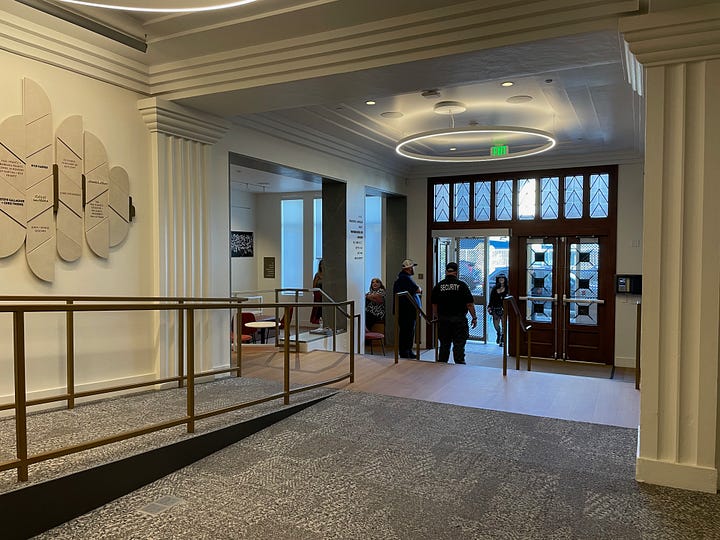
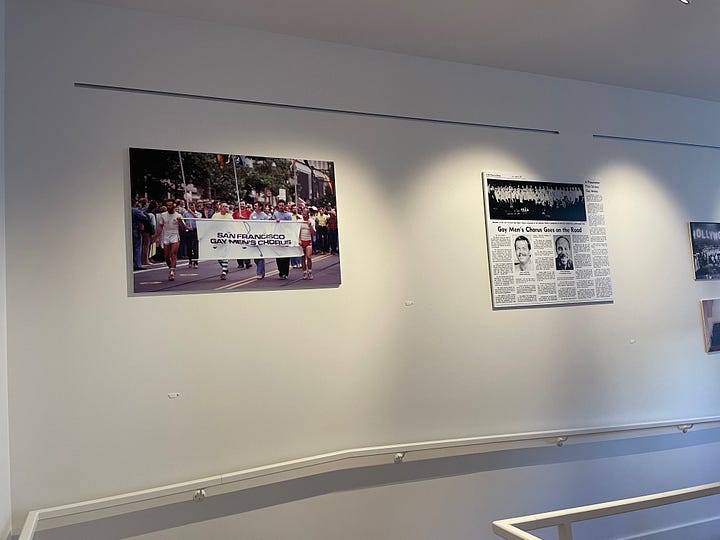

The telling of this evening-out garnered for me the approval of my old gay friends and won for me the trust of a new colleague who saw my post pop up in her feed. She had also caught up on my other posts, one about my work as a specialist in ADD which affirmed my professional status and the one on the Olympics. She wrote to me privately confessing that she had been defending the XY boxer as a woman, but thanks to my explanation could see that this wasn’t so and the concern for women at having their category opened up to men was at issue. She asked how she could keep up with this issue as she was an activist for the Democratic party. This was enormously satisfying.
It more than made up for having been battered by another colleague the previous week who called me a bigot in my piece about the boxers because I was faulting an individual for not passing as a woman just as racists once faulted Black people for not passing as white. An accusation I’d never heard of before. I stopped trying to reason with her and moved on to other topics. This topic of drag just happened to be in the cue aptly illustrating that men dressed as women were not the issue whether they passed or not.




You lost me at "two-spirit." That, too, is an artifact of recolonization rooted in questionable anthropology, white hippie woo and the myth of the noble savage.
I view drag queens as histrionic barflies who suck all of the oxygen out of the room with their incessant demands for attention. It's their party and then can drag if they want to, but I'll be damned if I will call them all artists or imbue their costume shows with special cultural significance. Drag is a tired holdover from the pre-Stonewall era when gay people sought identity and protection by developing a subculture that included camp and drag as unifying features. Drag is about as culturally relevant today as Liberace.
Having spent time around the drag "courts" in Portland, Oregon in the early 80s, I came away with the impression that they were a way for lower middle class gay people to find community. In a different time and place they might have been Shriners.